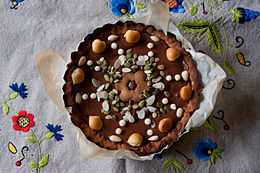Mazurek (cake)
| Mazurek | |
|---|---|
| Pastry | |
 Traditional home-made Mazurek | |
| Place of origin: | |
| Poland | |
| Main ingredient(s): | |
| flour, sugar, butter or margarine, egg, milk, salt, icing, fruit, nuts | |
| Recipes at Wikibooks: | |
|
| |
| Media at Wikimedia Commons: | |
|
|
Mazurek is a variety of pastry (a cake) baked in Poland, both at Easter, and also at Christmas and holiday season.[1] A generous layer of icing (usually chocolate) is evenly spread over it and then decorated with dried fruit, walnuts, almonds, roasted seeds etc.[2]
Mazurek tradition

The mazurek's name might have originated from the word Mazur (or Masurian) tribe inhabiting the Mazovia region of central Poland, or perhaps from the word mazurek (Polish for mazurka), traditional folk dance in triple metre from Poland.[3] A shortcrust pastry, Mazurek is considered one of the primary desserts of Easter across Poland. What distinguishes it from other festive dessert cakes is the abundance of decoration with dried fruit and nuts, its overall sweetness, and chocolate icing, contributing to its prolonged freshness.[3]
Although considered uniquely Polish, almost a seasonal national dessert,[4] the recipe for Mazurek came to Poland most likely via the spice trade-route from Turkey in early 17th century. Its symbolism is closely associated with the period of Wielki Post (Polish for Lent) thus marking its successful completion. In fact, after a 40-day fast (not a total abstinence from food by any means), which is celebrated in Christian lithurgy in memory of the Temptation of Christ, mazurek was supposed to be the rich reward for adherence to faith and tradition. Although today, the religious meaning of mazurek is virtually lost in Poland, the cake is closely associated with the seasonal celebrations nevertheless.[4]
Official designation
Mazurek was entered onto the list of Polish traditional dessert products for the Kuyavian-Pomeranian Voivodeship by the Ministry of Rural Development on 3 November 2011, described in a particular way. It is supposed to be rectangular, 20 centimetres (7.9 in) by 40 centimetres (16 in) in size, very sweet with distinct aroma of walnuts, golden or golden-brown in color, considerably flat, with shortcrust base prepared separately, and thick layer of icing decorated with dried fruit and nuts into a pattern.[5] The Polish edition of Newsweek magazine offered a gallery of ideas about how to decorate mazurek with slivered almonds and sliced dates including chocolate-written greetings.[6] News portal Wirtualna Polska insisted that mazurek cannot resemble any other regular cake. It is supposed to be flat in multitude of varieties, each with different flavour and lavishly decorated.[7] Twelve of them (served side by side, as claimed by the magazine), would not be entirely out of line traditionally.[7] At Christmas, the emphasis on a symbolic number twelve is closely related to the Twelve Apostles at the Last Supper,[8] celebrated by Catholics by twelve different food offerings.[9] The secret of a good mazurek is to have the quickly assembled cake base chilled for half an hour before baking.[7]
References
- ↑ "Liturgical Year Recipes: Mazurek". Source: Feast Day Cookbook by Katherine Burton & Helmut Ripperger, David McKay publishing, New York. Catholic Culture. 2013. Retrieved 24 December 2013.
- ↑ Patryk A. Nachaczewski (14/2007). "Babki i mazurki". Interview with Maciej Gadziński. Przewodnik Katolicki. Retrieved 11 December 2013.
- ↑ 3.0 3.1 K.T. (2013). "Święta Wielkanocne: Mazurek – skąd taka tradycja i nazwa mazurek?". Miesięcznik Podróże.pl. Retrieved 11 December 2013.
- ↑ 4.0 4.1 Contributing writer (3 April 2011). "Co wiesz o wielkanocnym mazurku?". Serwisy zdrowotne Edipresse Polska S.A. Wiesz Jak.pl Zdrowie. Retrieved 11 December 2013.
- ↑ Staff writer (2013). "Mazurek orzechowy". Jakość żywności. Lista produktów tradycyjnych. Ministerstwo Rolnictwa i Rozwoju Wsi, Warsaw. Retrieved 11 December 2013.
- ↑ "Mazurek na wielkanocnym stole". Galerie. Newsweek.pl. 19 April 2011. Retrieved 11 December 2013.
- ↑ 7.0 7.1 7.2 Staff writer (3 April 2006). "Mazurki wielkanocne". Kobieta.wp.pl, kulinaria (in Polish). Wirtualna Polska. Archived from the original on 13 December 2013. Retrieved 13 December 2013. "(Translation: If the tradition is to be followed, there should be 12 mazurek cakes at Easter, each with different flavour.) Aby tradycji stało się zadość, na wielkanocnym stole powinno być ich 12, a każdy o innym smaku."
- ↑ Ann Hetzelgunkel (2013). "Mazurka at Polish Christmas Wigilia Meal & Foods". Courses of the Meal / Menu. Polish Christmas. Retrieved 24 December 2013.
- ↑ Ludmiła Jezierska (2007). "Symbolika świąt Bożego Narodzenia (The Symbolism of Christmas)" (in Polish). Urząd Marszałkowski Województwa Pomorskiego. Retrieved 24 December 2013.